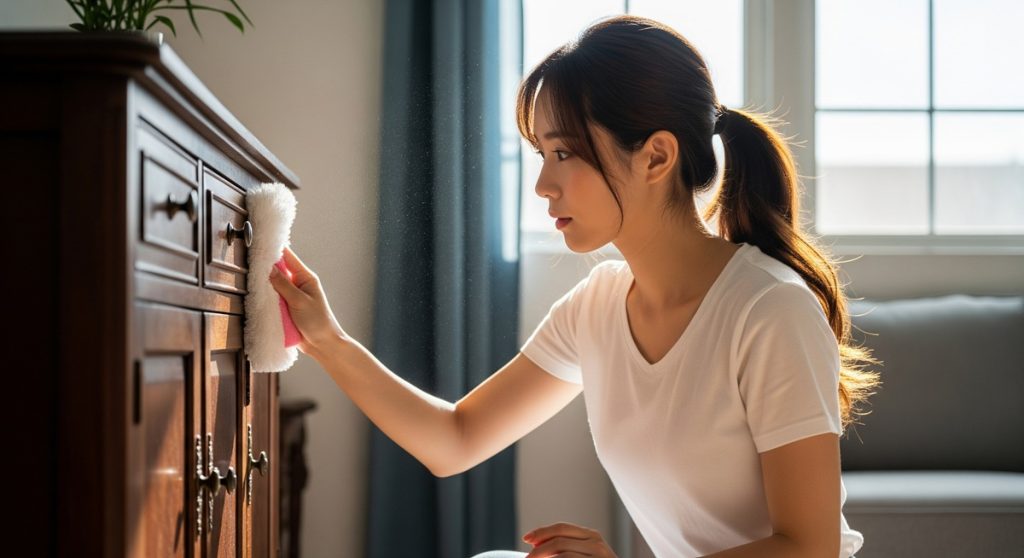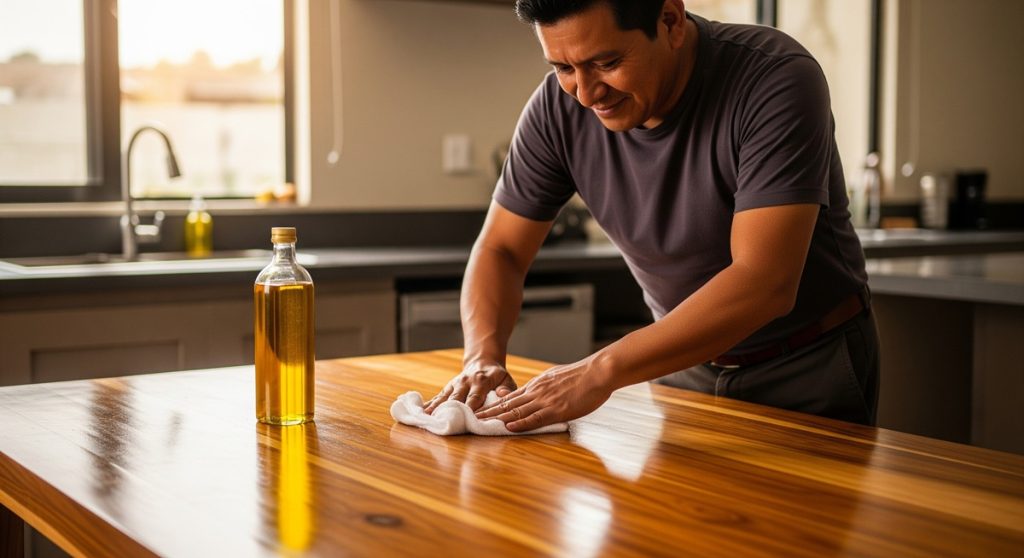Teak is renowned for its exceptional durability and natural beauty, making it a prized material for indoor furniture. While it’s relatively low-maintenance, understanding how to care for indoor teak furniture properly ensures your pieces remain stunning for decades.
This comprehensive guide will equip you with the knowledge to preserve your teak’s timeless appeal, whether you’ve just acquired a new piece or inherited a cherished heirloom.
Table of Contents
Why Teak is So Special for Indoor Furniture
Before diving into the care routine, it’s helpful to appreciate what makes teak an ideal choice for your home:
- Natural Oil Content: Teak’s inherent oils provide natural resistance to water, pests, and rot, which is why it’s a favorite for demanding environments like boat decks and tropical settings. This natural protection also makes it excellent for indoor use.
- Strength and Stability: As a hardwood with a robust grain structure, teak stands up remarkably well against warping, shrinking, and swelling, even in fluctuating indoor humidity levels.
- Timeless Appearance: Teak develops a unique character over time, evolving from a warm golden-brown to a distinguished silvery patina. With proper care, its beauty only deepens with age.
In essence, teak is incredibly resilient, but with the right care, its elegance and longevity are significantly enhanced.
Essential Daily and Weekly Cleaning for Indoor Teak

Regular cleaning is the cornerstone of how to care for indoor teak furniture, especially for frequently used items like dining tables and coffee tables.
- Dusting (2–3 times a week): Use a soft microfiber or dry cloth to gently remove dust. This simple step prevents dirt from accumulating in the wood grain, which can otherwise make cleaning more challenging.
- Immediate Spill Wiping: While teak is naturally moisture-resistant, it’s not entirely stain-proof, particularly if your furniture has an oil or matte finish.
- Do: Wipe up any spills immediately with a soft, damp cloth.
- Don’t: Allow liquids like water, wine, or coffee to sit on the surface for extended periods.
- Crucial Tip: Always avoid harsh chemicals, bleach, or abrasive multi-surface sprays, as these can severely damage your teak’s finish.
- Weekly Wipe-Down: For a general clean, dampen a cloth with clean water and wring it out thoroughly before wiping the furniture. For a deeper clean, add a few drops of mild dish soap to warm water, gently wipe the surface, and then follow with a wipe-down using only clean water to remove any soap residue.
Maintaining Your Teak’s Finish: Oiled vs. Natural

Indoor teak furniture can have various finishes, and your how to care for indoor teak furniture approach will depend on it:
- Natural Unfinished Teak: If you prefer the “raw” look, your teak will gradually develop a beautiful silvery-gray patina over time.
- Care: No oiling is required. Simply follow the regular cleaning tips above.
- Note: Try to avoid placing unfinished teak in areas with intense direct sunlight or extreme humidity to ensure even aging.
- Oiled Finish: Most indoor teak furniture is sold with an oiled finish, which enhances its rich, warm golden-brown color. This oil layer will naturally diminish over time, and reapplication is key to maintaining the desired look. How to Re-oil Your Teak (Every 6–12 Months, or as needed):
- Clean: Ensure the surface is thoroughly clean and dry.
- Light Sand (Optional): For older pieces or if the surface feels rough, lightly sand with 400-grit sandpaper.
- Apply Oil: Use a lint-free cloth to apply a quality teak oil (or Danish oil).
- Soak & Wipe: Allow the oil to soak into the wood for 15–30 minutes, then wipe off any excess.
- Cure: Let the furniture cure overnight before use.
- Remember: Don’t over-oil. Once or twice a year is typically sufficient to revitalize the finish.
Fixing Common Issues: Scratches, Water Rings, and Stains

Even the most durable teak furniture can encounter daily wear. Thankfully, minor imperfections are often easy to address when you know how to care for indoor teak furniture for repairs.
- Minor Scratches:
- Walnut Trick: Gently rub a walnut across the scratch. The natural oils in the nut can help blend the mark.
- Deeper Scratches: For more noticeable scratches, lightly sand the affected area and then re-oil as described above.
- Water Rings:
- Warm Iron Method: Place a clean cloth over the water ring. Lightly press a warm iron (with no steam) over the cloth for 15–30 seconds. The gentle heat helps draw out the trapped moisture.
- Stubborn Stains:
- Baking Soda Paste: Mix equal parts baking soda and water to form a paste. Gently scrub the stain with a soft cloth or sponge. Rinse thoroughly with clean water and let the area dry completely before re-oiling (if applicable).
- Warning: Never use abrasive cleaners, scouring pads, or power sanders on your teak furniture, as these can cause irreparable damage.
Protecting Teak from Environmental Factors

Understanding how to care for indoor teak furniture also means protecting it from its environment. While teak is stable, prolonged exposure to certain conditions can impact its appearance.
- Sunlight and Heat Protection:
- Uneven Fading: Direct, prolonged sunlight can cause uneven fading of the wood or drying/cracking of surface finishes.
- Heat Marks: Placing hot items directly on the surface without protection can leave marks.
- Smart Prevention:
- Utilize curtains or UV window film in exceptionally sunny rooms.
- Periodically rotate or move your teak furniture to ensure even exposure to light.
- Always use coasters, placemats, and heat-resistant pads on tables.
- Humidity, Air Conditioning & Storage:
- Climate Tips: While teak handles tropical climates well, avoid extreme moisture shifts. If you use air conditioning constantly in a very dry climate, a humidifier can help maintain optimal moisture levels for your wood. Avoid placing furniture directly under air vents or next to heaters.
- Protecting Legs: Use felt pads or rubber feet under furniture legs to prevent moisture buildup from the floor.
- Storing Teak Furniture: If storing a piece for an extended period:
- Clean and dry it completely.
- Wrap it in a breathable cover (avoid plastic, which can trap moisture).
- Store in a well-ventilated, dry area.
Caring for Upholstered Teak Furniture

If your teak chairs, benches, or daybeds include cushions, remember to extend your care to the soft elements:
- Regular Cleaning: Vacuum or dust cushions weekly to prevent dirt buildup.
- Spot Cleaning: Address spills or stains on fabric promptly using fabric-safe cleaners according to the manufacturer’s instructions.
- Rotation: Rotate cushions regularly to ensure even wear and tear.
- Pro Tip: Removable cushion covers with zippers greatly simplify cleaning. Inquire about this feature when purchasing or ordering custom furniture.
When to Consider Refinishing or Restoring Your Teak Furniture

One of the greatest advantages of solid teak is its capacity for restoration. Knowing how to care for indoor teak furniture includes recognizing when it’s time for a more significant refresh.
You might want to refinish when:
- The surface appears dull and lifeless even after re-oiling.
- There are noticeable cracks, deep scratches, or persistent stains.
- You wish to change the furniture’s color or overall style.
A light sanding followed by a fresh coat of oil or stain can truly breathe new life into an old piece. If you’re not comfortable doing it yourself, many furniture workshops, including ours, offer professional refinishing services for older teak pieces.
Your Indoor Teak Furniture Maintenance Checklist
| Task | Frequency |
|---|---|
| Dusting | 2–3 times a week |
| Wipe with damp cloth | Weekly |
| Re-oiling | Every 6–12 months |
| Rotate or move furniture | Every few months |
| Sanding/Refinishing | As needed (every few years) |
| Cushion cleaning | Monthly or as needed |
Conclusion: A Little Care Goes a Long Way
Teak furniture is a testament to natural beauty and enduring quality. While it demands little, providing consistent and proper care will ensure it rewards you with decades of stunning performance.
Understanding how to care for indoor teak furniture is not just about maintenance; it’s about preserving a legacy. It’s about enjoying pieces that not only furnish your space but also tell a story and grow more beautiful with every passing year.



